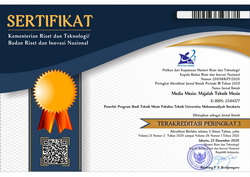PENINGKATAN KEKUATAN LENTUR PRODUK 3D PRINTING BERBAHAN PETG DENGAN OPTIMASI PARAMETER PROSES MENGGUNAKAN METODE TAGUCHI
Eduar Iqbal Riza(1), Cahyo Budiyantoro(2), Aris Widyo Nugroho(3*)(1) Mechanical Engineering Department Universias Muhammadiyah Yogyakarta
(2) Universitas Muhammadiyah Yogyakarta
(3) Universitas Muhammadiyah Yogyakarta
(*) Corresponding Author
Abstract
Optimization of 3D printing process parameters with PETG material to the flexural strength response using the Taguchi method has been carried out. This study uses L9 (33) orthogonal arrays experimental design using three process parameters, namely nozzle temperature, extrusion width, and feed rate with three levels in each parameter (240 ° C, 245 ° C, 250 ° C, 0.3 mm 0.35mm, 0.4mm, 50%, 75%, 100%). Specimens were prepared according to ISO 178: 2010 Standard using a Prusa-i3 3D printer. Following this their dimensions, mass, production time, and flexural strength were examined. The flexural strength response was analyzed using the Taguchi method via SN Ratio and ANOVA analysis to obtain the optimal parameters. The results showed that the most influential process parameters on the response of flexural strength respectively were the nozzle temperature, extrusion width and feed rate with an optimal combination of parameters namely nozzle temperature (250 ° C), extrusion width (0.35 mm), and feed rate (75%). The confirmation experiments showed that the optimal parameter combination obtained the highest flexural strength with a smaller data deviation (52.98 ± 0.65 MPa). In addition, all products being produced posses dimensions according to the standards used.
Keywords
Full Text:
PDF (Bahasa Indonesia)References
Thomas, D. J. and Claypole, T. C., 2016, 3-D Printing. United Kingdom: Elsevier. pp. 293-306.
Mohamad, O. A, Masood, S.H and Bhowmik, J. L., 2015, Optimization of Fused Deposition Modeling Process Parameters: A Review of Current Research And Future Prospects. Advances in manufacturing, vol. 3, no. 1, pp. 42-53, DOI: 10.1007/s40436-014-0097-7
Grabowik, C., Kalinowski, K., Ćwikła, .,Paprocka, I., & Kogut, P., 2017, Tensile tests of specimens made of selected group of the filament materials manufactured with FDM method. MATEC Web Conf. 112, 1-6.
Nugroho, A.W., Mahardika,A.H., and Budiantoro, C., 2019 Improving the tensile properties of 3D printed PLA by optimizing the processing parameter. JEMMME (Journal of Energy, Mechanical, Material, and Manufacturing Engineering),4(1): p. 29-36.
Sukindar, N. A. B., Ariffin, M., Baharudin, B., Jaafar, C., & Ismail, M., 2017, Analysis on the Impact Process Parameters on Tensile Strength Using 3d Printer Repetier-Host Software. ARPN Journal of Engineering and Appled Science, pp. 12, 3341-3346
Lužanin, O., Movrin, D. and Plančak, M., 2014, Effect Of Layer Thickness, Deposition Angle, and Infill On Maximum Flexural Force in Fdm-Built Specimens. Serbia: University of Novi Sad, Faculty of Technical Science, 39. pp. 51-58.
Szczepanik, S., and Bednarczyk, P., 2017, Bending and Compression Properties of ABS and PET Structural Materials Printed Using FDM Technology. Poland: AGH University of Science and Technology Press, 1. pp. 39-42.
Christiyan, K. J., Chandrasekhar, U., & Venkateswarlu, K., 2016, A study on the influence of process parameters on the Mechanical Properties of 3D printed ABS composite. IOP Conference Series. 114, 1.
Szykiedans, K., Credo, W., & Osiński, D. , 2017, Selected Mechanical Properties of PETG 3-D Prints. Poland: Elsevier, 177. pp. 455-461.
Menderes, K., İpekçi, A., & Saruhan, H., 2017, Investigation of 3D Printing Filling Structures Effect on Mechanical Properties and Surface Roughness of PET-G Material Products. Turkey: Gaziosmanpasa Journal of Scientific Research, 6. pp. 114-121.
Article Metrics
Abstract view(s): 1258 time(s)PDF (Bahasa Indonesia): 1253 time(s)
Refbacks
- There are currently no refbacks.








